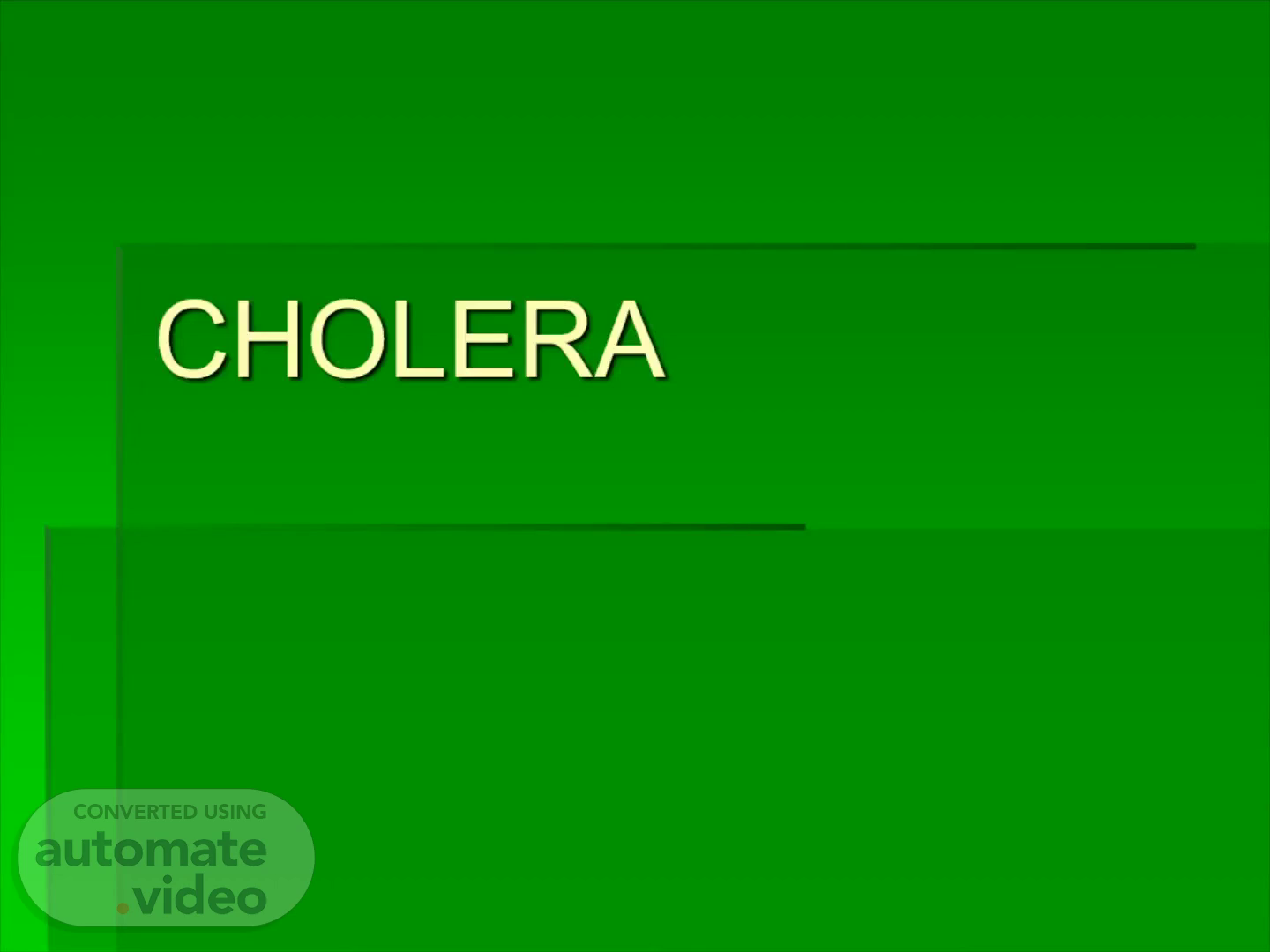Scene 1 (0s)
CHOLERA.
Scene 2 (5s)
Cholera, is a Greek word, which means the gutter of the roof. It is caused by bacteria vibrio cholerae, which was discovered in 1883 by Robert Koch during diarrhea outbreak in Egypt..
Scene 3 (24s)
The organism is a comma-shaped, gram-negative, aerobic bacillus whose size varies from 1-3 mm in length by 0.5-0.8 mm in diameter..
Scene 4 (42s)
V. CHOLERAE. Cholera Bacterium.
Scene 5 (49s)
Since 1817, there have been 7 cholera pandemics. The first 6 occurred from 1817-1923 and were caused by V cholerae, the classical biotype. The pandemics originated in Asia with subsequent spread to other continents..
Scene 6 (1m 7s)
In October 1992, an epidemic of cholera emerged from Madras, India as a result of a new serogroup (0139)..
Scene 7 (1m 23s)
The number of cholera patients worldwide is uncertain because most cases go unreported..
Scene 8 (1m 41s)
Mortality/ Morbidity. During the six pandemic, the case fatality rates were very high (50-70%).
Scene 9 (1m 56s)
MECANISM :- Cholera is a toxin- mediated disease These toxins acts on the small intestine To reach the small intestine, the organisms has to overcome the defense mechanisms of the GIT (acidic media in the stomach).
Scene 10 (2m 14s)
PATHOGENESIS/2. They secrete certain mucinase which help it to move rapidly through the mucus They also depend on the large inoculums size (so they bypass the gastric acidity) Then got adherent to the epithelial surface, probably by certain factor.
Scene 11 (2m 28s)
PATHOGENESIS/3. Then they produce their enterotoxin which consist of 2 types ,light one( L toxin) , & heavy ( H toxin) The L toxin combines with a substance known as gangliosides , the products make the organism bind to the cell wall, this binding is irreversible.
Scene 12 (2m 42s)
PATHOGENESIS/4. The H toxin acts by activating adenylecyclase, this activation leads to rise in the level of the so called 3, 5-adenosine monophosphate (cAMP).
Scene 13 (2m 53s)
PATHOGENESIS/5. This substance inhibits the absorptive sodium transport & activates the excretory chloride in the intestinal cell→ accumulation of NaCl in the intestinal lumen This high osmolality is balanced by water secretion, the result is watery diarrhea.
Scene 14 (3m 17s)
Fluid loss originates in the duodenum and upper jejunum; the ileum is less affected..
Scene 15 (3m 30s)
PATHOGENESIS/5. The large volume of fluid produced in the upper intestine, however, overwhelms the absorptive capacity of the lower bowel, which results in severe diarrhea The enterotoxin acts locally & does not invade the intestinal wall. As a result few WBC & no RBC are found in the stool..
Scene 16 (3m 46s)
AGENT FACTORS. Resistance:- v. cholerae are killed within 30 minutes at 56 deg.C, or few sec. by boiling Remain in ice for 3-4 weeks or longer Drying & sunshine will kill them in few hours Disinfectant kill them also.
Scene 17 (4m 0s)
RESERVOIR OF INFECTION. Human is the only known reservoir of cholera infection The ratio of severe cases to mild ones is shown to be 1:5 for classical type & 1:25 for EL Tor.
Scene 18 (4m 13s)
Cholera is transmitted by the fecal-oral route through contaminated water & food..
Scene 19 (4m 34s)
V cholerae is a saltwater organism & it is primary habitat is the marine ecosystem..
Scene 20 (4m 52s)
The use of antacids, histamine-receptor blockers, and proton-pump inhibitors increases the risk of cholera infection and predisposes patients to more severe disease as a result of reduced gastric acidity..
Scene 21 (5m 9s)
All ages, but children & elderly are more severely affected..
Scene 22 (5m 22s)
Incubation period is 24-48 hours.. Symptoms begin with sudden onset of watery diarrhea, which may be followed by vomiting. Fever is typically absent..
Scene 23 (5m 42s)
Breast-fed infants are protected.. Symptoms are severe & fever is frequent..
Scene 24 (5m 57s)
If dehydration is not corrected adequately & promptly it can lead to hypovolemic shock, acute renal failure & death..
Scene 25 (6m 11s)
Organism can be seen in stool by direct microscopy after gram stain & dark field exam is used to demonstrates motility..
Scene 26 (6m 29s)
Dehydration leads to high blood urea & serum creatinine. Hematocrit & WBC will also be high due to hemoconcentration..
Scene 27 (6m 46s)
The primary goal of therapy is to replenish fluid losses caused by diarrhea & vomiting..
Scene 28 (7m 0s)
WHO Guidelines. Step (1) : Assess degree of dehydration Step (2) : Rehydrate the patient & monitor signs frequently Step (3): Maintain hydration Step (4): Administer oral antibiotics to patient with severe dehydration Step (5): Feed the patient.
Scene 29 (7m 15s)
SEVERE DEHYRATION. Administer IV fluids immediately Monitor the patient very frequently, (radial pulse & BP) Re-assess the patient after 3 hours (if still having signs, repeat the IV fluid).
Scene 30 (7m 26s)
Ringer lactate solution is preferred over normal saline because it corrects the associated metabolic acidosis..
Scene 31 (7m 44s)
The goals of drug therapy are to eradicate infection, reduce morbidity and prevent complications..
Scene 32 (7m 59s)
Drug therapy reduces volume of stool & shortens period of hospitalization. It is only needed for few days (3-5 days)..
Scene 33 (8m 17s)
Education on hygienic practices.. Provision of safe, uncontaminated water to the population..
Scene 34 (8m 29s)
The old killed injectable vaccine is obsolete now because it is not effective..
Scene 35 (8m 46s)
Verification of the diagnosis. Notification of the case to MOH & WHO..
Scene 36 (8m 59s)
THANKS FOR YOUR ATTENTION. roe. .
